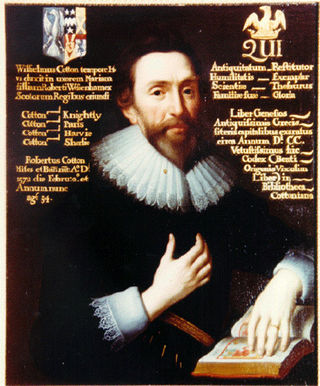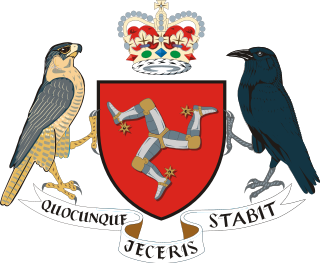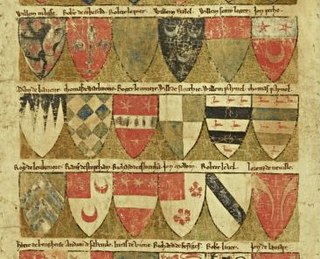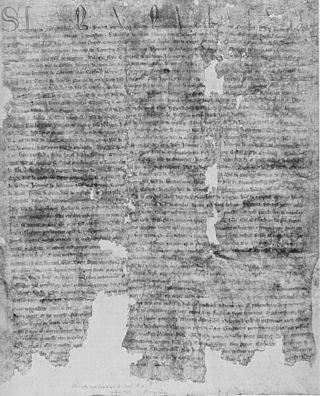
Sir Robert Bruce Cotton, 1st Baronet of Conington Hall in the parish of Conington in Huntingdonshire, England, was a Member of Parliament and an antiquarian who founded the Cotton library.
Leod was the eponymous ancestor and founder of Clan MacLeod and Clan MacLeod of Lewis. Almost nothing is known about him and he does not appear in any contemporary records. Tradition dating to the late 18th century made him a son of Olaf the Black who was King of Man. Heraldic evidence, dating to the late 17th century, is considered to be the earliest evidence of descent from Olaf the Black. However, in recent years, this traditional lineage has been challenged and is no longer considered fact by one historian.

Sir John Donne was a Welsh courtier, diplomat and soldier, a notable figure of the Yorkist party. In the 1470s, he commissioned the Donne Triptych, a triptych altarpiece by Hans Memling now in the National Gallery, London. It contains portraits of him, his wife Elizabeth and a daughter. He may well have been related to the Jacobean poet John Donne, although not as a direct ancestor, as he had no Donne grandchildren.

The coat of arms of Ireland is blazoned as Azure a harp Or, stringed Argent. These arms have long been Ireland's heraldic emblem. References to them as being the arms of the king of Ireland can be found as early as the 13th century. These arms were adopted by Henry VIII of England when he ended the period of Lordship of Ireland and declared Ireland to be a kingdom again in 1541. When the crowns of England, Scotland and Ireland were united in 1603, they were integrated into the unified royal coat of arms of kingdoms of England, Scotland and Ireland. The harp was adopted as the emblem of the Irish Free State when it separated from the United Kingdom in 1922. They were registered as the arms of Ireland with the Chief Herald of Ireland on 9 November 1945.

The coat of arms of Scotland, colloquially called the Lion Rampant, is the coat of arms historically used as arms of dominion by the monarchs of the Kingdom of Scotland, and later by monarchs of Great Britain and the United Kingdom. The coat of arms, or elements from it, are also used in heraldry to symbolise Scotland in general. The arms consist of a red lion surrounded by a red double border decorated with fleurs-de-lis, all on a gold background. The blazon, or heraldic description, is: Or a lion rampant Gules armed and langued Azure within a double tressure flory-counter-flory of the second.

A roll of arms is a collection of coats of arms, usually consisting of rows of painted pictures of shields, each shield accompanied by the name of the person bearing the arms.

The Coat of Arms of the Isle of Man, blazoned Gules three legs in armour flexed at the knee and conjoined at the thigh, all proper, garnished and spurred or, dates from the late 13th century. The present version dates from 12 July 1996. As the Isle of Man is a Crown dependency and the present Lord of Man is King Charles III of the United Kingdom, the arms are more accurately described as the Arms of His Majesty in right of the Isle of Man. The origin of the triskeles is obscure, but it appears to stem from the Scottish takeover of the island in 1265. The heraldic supporters are birds associated with the island, whilst the motto first appears on record in the 17th century.

The lion is a common charge in heraldry. It traditionally symbolises courage, nobility, royalty, strength, stateliness and valour, because historically the lion has been regarded as the "king of beasts". The lion also carries Judeo-Christian symbolism. The Lion of Judah stands in the coat of arms of Jerusalem. Similar-looking lions can be found elsewhere, such as in the coat of arms of the Swedish royal House of Bjelbo, from there in turn derived into the coat of arms of Finland, formerly belonging to Sweden.

In heraldry, a bordure is a band of contrasting tincture forming a border around the edge of a shield, traditionally one-sixth as wide as the shield itself. It is sometimes reckoned as an ordinary and sometimes as a subordinary.

Baron Talbot is a title that has been created twice. The title was created first in the Peerage of England. On 5 June 1331, Sir Gilbert Talbot was summoned to Parliament, by which he was held to have become Baron Talbot.
Francis Thynne was an English antiquary and an officer of arms at the College of Arms.

Scrope v Grosvenor (1389) was an early lawsuit relating to the law of arms. One of the earliest heraldic cases brought in England, the case resulted from two different knights in King Richard II's service, Richard Scrope, 1st Baron Scrope of Bolton, and Sir Robert Grosvenor, discovering they were using the same undifferenced coat of arms, blazoned Azure, a bend Or. This had previously gone unnoticed because the armigers' families were from different parts of England. As the law of arms by the 14th century prohibited armigers within the same system of arms from holding the same undifferenced arms, Scrope brought suit against Grosvenor in 1386 to determine who would be allowed to continue using the arms in question; the Court of Chivalry found in Scrope's favour in 1389, and King Richard affirmed the decision the following year.

In heraldry and heraldic vexillology, a blazon is a formal description of a coat of arms, flag or similar emblem, from which the reader can reconstruct the appropriate image. The verb to blazon means to create such a description. The visual depiction of a coat of arms or flag has traditionally had considerable latitude in design, but a verbal blazon specifies the essentially distinctive elements. A coat of arms or flag is therefore primarily defined not by a picture but rather by the wording of its blazon. Blazon is also the specialized language in which a blazon is written, and, as a verb, the act of writing such a description. Blazonry is the art, craft or practice of creating a blazon. The language employed in blazonry has its own vocabulary, grammar and syntax, which becomes essential for comprehension when blazoning a complex coat of arms.

In my defens God me defend is the motto of both the royal coat of arms of the Kingdom of Scotland and royal coat of arms of the United Kingdom used in Scotland. Contemporary versions of the royal arms show an abbreviated motto, in the form of in defens or, where English is used as an alternative, in defence. The motto appears above the crest of the arms, in the tradition of Scottish heraldry.

The Dering Roll is the oldest English roll of arms surviving in its original form. It was made between 1270 and 1280 and contains the coat of arms of 324 knights, starting with two illegitimate children of King John. Sir Edward Dering acquired the roll during the 17th century and modified it to include a fictitious ancestor of his own. It was eventually purchased by the British Library following fundraising involving a number of other charities and individuals.
Nicholas Charles or Carles was an English officer of arms, who served as Lancaster Herald from 1609 to 1613. He made a copy of an early and rare 13th-century roll of arms, the original of which is now lost, known after him as "Charles's Roll".

Weare Giffard is a small village, civil parish and former manor in the Torridge district, in north Devon, England. The church and manor house are situated 2 1/2 miles NW of Great Torrington in Devon. Most of the houses within the parish are situated some 1/2-mile east of the church. The church is situated on a hillside to the north and slightly above the wide and flat valley floor of the River Torridge. The Church of the Holy Trinity and the adjacent Weare Giffard Hall are designated members of the Grade I listed buildings in Devon. In 2011 the parish had a population of 345.

The Barons' Letter of 1301 was written by seven English earls and 96 English barons to Pope Boniface VIII as a repudiation of his claim of feudal overlordship of Scotland, and as a defence of the rights of King Edward I of England as overlord of Scotland. It was, however, never sent. The letter survives in two copies, known as A and B, both held in the National Archives at Kew under the reference E 26. Historically they were held amongst the documents in the Exchequer, Treasury of the Receipt department.

An ordinary of arms is a roll or register of coats of arms arranged systematically by design, with coats featuring the same principal elements grouped together. The purpose of an ordinary is to facilitate the identification of the bearer of a coat of arms from visual evidence alone.

Heraldry is the system of visual identification of rank and pedigree which developed in the European High Middle Ages, closely associated with the courtly culture of chivalry, Latin Christianity, the Crusades, feudal aristocracy, and monarchy of the time. Heraldic tradition fully developed in the 13th century, and it flourished and developed further during the Late Middle Ages and the Early Modern period. Originally limited to nobility, heraldry is adopted by wealthy commoners in the Late Middle Ages. Specific traditions of Ecclesiastical heraldry also develop in the late medieval period. Coats of arms of noble families, often after their extinction, becomes attached to the territories they used to own, giving rise to municipal coats of arms by the 16th century.





















